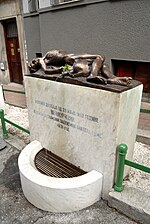House of Stevan Mokranjac, Belgrade

House of Stevan Mokranjac in Belgrade is significant as the house where the famous composer Stevan Stojanović Mokranjac lived and worked, during his stay in Belgrade. It is located on the corner of 16, Dositej Street and Gospodar Jevremova. The house was built as a family house of Jakov Damjanović, building contractor, in 1872. From July 1878 to May 1879, the house was used for housing the humanitarian organization of the English Institute for Serbian Orphans, later the Institute for Serbian Orphans, which was founded by English physician Dr. Henri Ciman after the Serbian-Turkish wars and for whose needs, a garden wing was added next to the building. In the house, Stevan Stojanović Mokranjac (1856—1914) lived and worked, as the most prominent Serbian composer and choirmaster, teacher and collector of folk melodies with which he enriched art music. He completed his music studies studied in Germany and Italy. He was a representative of musical realism and one of the most important figures in the history of Serbian music at the turn of the 19th to the 20th century. highest achievement was reached by his work Руковети, and one of his most important and most frequently performed spiritual compositions is the Liturgy of St. John Chrysostom.
Excerpt from the Wikipedia article House of Stevan Mokranjac, Belgrade (License: CC BY-SA 3.0, Authors, Images).House of Stevan Mokranjac, Belgrade
Dositejeva, Belgrade Old Town (Stari Grad Urban Municipality)
Geographical coordinates (GPS) Address External links Nearby Places Show on map
Geographical coordinates (GPS)
| Latitude | Longitude |
|---|---|
| N 44.8186 ° | E 20.4631 ° |
Address
Кућа Стевана Мокрањца
Dositejeva 16
11000 Belgrade, Old Town (Stari Grad Urban Municipality)
Central Serbia, Serbia
Open on Google Maps










